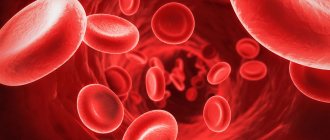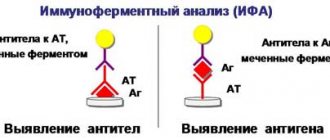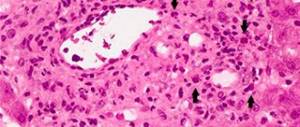- Alkaline phosphatase (ALP, Alkaline phosphatase) is the common name for a group of intracellular enzymes, an “accelerator” of a number of biochemical reactions, an indispensable participant in phosphorus-calcium metabolism.
Alkaline phosphatase is found in all tissues of the body.
It is especially abundant in cell membranes. It enters the blood of a healthy person in sufficient quantities due to the natural death of “old” cells and the physiological activity of osteoblasts (bone tissue cells). “Champions” for the production of alkaline phosphatases: - epithelium of the bile ducts and membranes of liver cells, - bone tissue, - as well as: placenta (in pregnant women), intestinal epithelium and renal tubules.
What is alkaline phosphatase
This term refers to a whole group of isoenzymes that are found in almost all human tissues, with the highest concentrations in the liver, biliary tract, bone tissue and placenta . Phosphatase, creating an alkaline environment, breaks down phosphoric acid into salts (phosphates) with the release of phosphorus, which can penetrate the cell membrane. When cells containing the enzyme are destroyed, it enters the blood. Since cells are constantly renewed, there is always a certain level of enzyme concentration.
What causes the decline?
A decrease in ALP levels in the blood may indicate that there are diseases in the body that require treatment:
- deficiency of thyroid hormones (hypothyroidism), as a consequence, the development of myxedema (mucoedema), retardation in mental and physical development (cretinism);
- severe anemia;
- intestinal enzymopathy (celiac disease, celiac disease);
- congenital anomalies of skeletal development (achondroplasia, hypophosphatasia).
In addition, ALP may be below normal as a result of:
- deficiency of vitamins – groups C and B (B6, B9, B12);
- lack of elements - zinc and magnesium;
- excess vitamin D;
- severe dystrophy due to protein deficiency (kwashiorkor);
- donor blood transfusion, coronary artery bypass surgery;
- placental insufficiency during pregnancy;
- menopause;
- taking hormonal medications containing estrogen.
Among the cardiovascular reasons why phosphatase may be reduced is chronic heart failure, which leads to enlargement of the heart chambers and their pathological expansion.
Along with low ALP levels, high cholesterol levels, tachycardia and blood vessel diseases are often diagnosed.
Conclusion: if the alkaline phosphatase level is above 150 U/l, you should pay attention to the state of your own health, especially if you already have chronic diseases of the liver and biliary tract.
The following symptoms may indicate a metabolic disorder: nausea, feeling tired, fatigue, poor appetite, joint pain, unpleasant aching sensations in the area under the right hypochondrium. If pathologies are excluded, then it is worth retaking the test a week after the first test, and following all recommendations regarding preparation for the test procedure.
What does alkaline phosphatase show in the blood?
ALP activity is associated with processes in the liver, bile ducts, and small intestine. Analysis of enzyme levels is very important in the diagnosis of liver pathologies, blockage of the bile ducts due to gallstones and pancreatic tumors, primary biliary cirrhosis and sclerosing cholangitis. Increased activity of bone cells also affects the level of phosphatase in the blood, which is important in the diagnosis of primary or secondary bone tumors.
High
Increased activity of alkaline phosphatase (other medical abbreviations - ALP, ALKP) during pregnancy is considered normal, and in other cases, as a rule, indicates liver disease or pathological processes in the bones. Under such conditions, some related indicators become important for diagnosis. Thus, a parallel increase in the levels of bilirubin, aspartate aminotransferase (AST), and alanine aminotransferase (ALT) is likely to indicate liver damage. Changes in the levels of minerals - calcium and phosphorus - will indicate pathology of bone tissue.
Low
Reduced levels of the ALP enzyme are much less common than increased levels. This result can be achieved by taking oral contraceptives, blood transfusions, or a lack of magnesium and zinc in the body. In addition, low levels of bone isoenzymes are a leading indicator of hypophosphatasia, a rare genetic disease characterized by impaired bone formation. If the disease manifests itself in children (juvenile form), it is characterized by frequent fractures, rickets, and tooth loss.
Analysis
The ALP level is determined by blood serum, often during biochemical analysis, sometimes separately. Blood is taken from a vein, the study is carried out on an empty stomach. Indications for analysis may include patient complaints of fatigue, weakness, loss of appetite, vomiting or nausea, darkening of urine and lightening of stool, pain in the right hypochondrium, yellowing of the skin and sclera. Doctors of various profiles are referred for the study: therapists, gastroenterologists, endocrinologists, urologists, infectious disease specialists, hematologists.
ALP - what is it, appointment for analysis
ALP is a group of enzymes that perform very important functions in the human body
Alkaline phosphatase is always present in the blood, since cells tend to renew themselves and die, releasing elements of their contents into the blood.
Alkaline phosphatase is found in almost all tissues of the human body; the largest number of enzymes is found in liver cells, bile ducts, and bone cells.
ALP in a biochemical blood test is an indicator of the health or pathology of not only the liver and bones, but also the kidneys and other organs. For example, this indicator increases during pregnancy, since a large amount of alkaline phosphatase is contained in the placenta. During bone growth, childhood and adolescence, ALP levels also increase due to bone activity.
The level of enzyme in the blood varies depending on age.
A blood test for ALP is prescribed in the following cases:
- General condition check. The ALP indicator is included in the biochemical blood test. Its compliance with the norm can be checked during a preventive examination, as well as if the patient voluntarily wishes to verify his health.
- During pregnancy. While pregnant, a woman often donates blood. A biochemical blood test contains 80% of information about the state of the body, so if necessary, a pregnant woman can donate blood every 2 weeks. ALP analysis in this case will be an indicator of the integrity of the liver and kidney tissues.
- For signs of liver damage. An ALP test may be prescribed for the following symptoms: nausea, weakness, vomiting, heaviness after eating, pain in the right hypochondrium. These signs may indicate liver disease, obstruction of the bile ducts.
- For bone diseases. ALP levels increase with bone fractures, but in this case x-rays are more informative. An alkaline phosphatase test is prescribed for bone diseases, as well as suspected metastases in bone tissue.
Alkaline phosphatase level
The normal level of alkaline phosphatase in the blood is considered to be between 20 and 140 IU/l. This is an average value that varies greatly depending on the gender and age of the person. The highest rates are observed in children and adolescents during active growth, as they are constantly dividing bone tissue. In addition, doctors identify about 200 drugs, the use of which can change the activity of the liver isoenzyme and affect the analysis data (usually in the direction of increase).
In men
ALP indicators for men are given below (in young people under 30 years of age, the results may be slightly above the upper limit of normal; doctors do not classify this as a pathology):
| Age, years | ALP level, IU/l |
| 17-30 | 40-110 |
| 31-45 | up to 120 |
| 46-54 | up to 130 |
| 55-69 | up to 145 |
| over 70 | up to 190 |
Among women
Abnormal levels of alkaline phosphatase, not associated with disease, can be observed in women during the third trimester of pregnancy (the reason is the placental isoenzyme released into the blood), during breastfeeding, due to excessive physical exertion. In other cases, the following norm of alkaline phosphatase in the blood of women is assumed:
| Age, years | ALP level, IU/l |
| 17-45 | 35-100 |
| 45-70 | up to 135 |
| over 70 | up to 165 |
In children
The most active periods of growth occur in the first year of life and adolescence. This is reflected in test results; an increase in alkaline phosphatase in children coincides with these periods.
Normal levels of alkaline phosphatase in the blood of children:
| Age | ALP level, IU/l |
| less than 15 days | 90-273 |
| from 15 days to 1 year | 134-518 |
| from 1 year to 10 years | 156-369 |
| teenagers (over 11) | 141-460 |
What causes the increase?
A high enzyme content is not always a sign of any pathology; it can also be a consequence of natural physiological causes or the body’s reaction to taking certain medications.
For example, it increases due to:
- bone growth due to age-related reasons;
- formation of new bone tissue after injuries;
- puberty, hormonal “changes”;
- age-related degenerative-dystrophic processes in the bone structure;
- intensive sports training;
- vitamin deficiency as a result of poor nutrition and dieting;
- alcohol and nicotine addiction;
- excess weight, excess fat deposits;
- low physical activity;
- excess vitamin C;
- taking medications containing acetylsalicylic acid, paracetamol, as well as medications classified as antibiotics;
- protection from pregnancy by taking oral contraceptives;
- taking drugs that have a negative toxic effect on liver tissue (sulfonamides, methotrexate, tetracycline).
An increase in alkaline phosphatase levels in women does not necessarily mean the presence of diseases of the internal organs. There are two main physiological causes that are not caused by any pathology - pregnancy and lactation.
However, enzyme values above normal often signal the presence of serious diseases. In severe forms of pathologies, the level of alkaline phosphatase can reach up to 2000 U/l.
Causes of increased alkaline phosphatase in the blood
High ALP in itself is not a diagnosis; additional research is needed , since the indicator can increase due to many reasons, including:
- Hepatitis of any origin (standards increased up to 3 times).
- Infectious mononucleosis, especially the first week of illness.
- Liver cirrhosis is a disease in which liver tissue is replaced by connective tissue, which negatively affects its functions. ALP in a biochemical blood test will also increase in cirrhosis of any etiology, autoimmune or alcoholic.
- Liver cancer or metastases to the area of this organ.
- Tumors of the pancreas or stomach, pressing on the area of the bile ducts. Blockage of the bile duct is called cholestasis.
- Primary kidney cancer.
- Gallstones.
- Paget's disease (norms exceeded by up to 15-20 times) is a rare disease characterized by pathological bone growth.
- Osteosarcoma or bone metastases of other tumors.
- Osteomalacia is a pathological calcium deficiency that causes softening of the bones.
- Myocardial infarction.
- Hyperparathyroidism is a thyroid disease in which calcium is washed out of the bones.
- Ulcerative colitis because ALP is found in intestinal cells.
Indications for the study
The results are prescribed and interpreted by specialists: therapist, gastroenterologist, hepatologist, infectious disease specialist, hematologist, endocrinologist, surgeon, general practitioner, pediatrician.
- Obstructive diseases of the liver and biliary tract;
- Inflammatory diseases of the biliary tract;
- Pathologies of the skeletal system, incl. primary and metastatic cancer;
- Oncological diseases of the kidneys;
- Infectious mononucleosis (an acute viral disease that causes liver damage).
- Individual monitoring of patients with osteoporosis receiving antiresorptive agents1.
An alkaline phosphatase test is mandatory in the program of routine medical examinations and when preparing a patient for surgery. Also, a phosphatase test is included in the list of “liver tests” when a diagnostic test of liver function is prescribed.
In addition, it is recommended to evaluate alkaline phosphatase activity if the patient complains of:
- increased fatigue;
- weakness;
- disturbance or lack of appetite;
- nausea/vomiting;
- pain in the abdomen/right hypochondrium;
- yellowness of the skin;
- change in the color of urine and/or feces;
- skin itching;
- feeling of aching bones;
- frequent fractures and/or bone deformities.
Repeated alkaline phosphatase testing is usually ordered to monitor the course of the disease and/or evaluate the effectiveness of treatment.
Causes of low alkaline phosphatase
During pregnancy, a decrease in alkaline phosphatase activity is considered an alarming symptom, as it may signal placental insufficiency. There are other reasons for the decline in the indicator:
- Hypothyroidism is insufficiency of the thyroid gland.
- Severe anemia.
- Condition after massive blood transfusion.
- Hypophosphatasia is a rare congenital disease that affects bone formation.
- Lack of magnesium and zinc.
Basic information
The group of phosphatases in the human body is represented by 11 isoenzymes, of which the most basic are:
- ALPI – intestinal phosphatase;
- ALPL – nonspecific (from liver, bone, kidney tissues) phosphatase;
- ALPP – placental phosphatase.
Normally, alkaline phosphatase consists of 2 fractions: bone and liver isoenzymes (bone - in osteoblasts, liver is secreted in bile), the quantitative content of which in blood serum is approximately the same. But in some cases, this ratio may change or be “diluted” by the inclusion of other types of isoenzymes. Such situations include pathological conditions, for example, damage to cells of a mechanical, inflammatory nature, or any physiological characteristics of the body.
The following diseases can provoke an increase in alkaline phosphatase activity:
- organs of the hepatobiliary system;
- musculoskeletal system;
- digestive tract organs;
- malignant neoplasms;
- endocrine disorders.
In addition, an increase in phosphatase values can be observed in completely healthy people with an intense (stronger than usual) metabolism, in pregnant women and in children during the period of active bone growth.
A decrease in alkaline phosphatase activity is recorded extremely rarely and most often this occurs against the background of insufficiency of the thyroid gland, malnutrition (fasting, strict diets), deficiency of vitamins and microelements, etc.
How to reduce alkaline phosphatase in the blood
There are a number of conditions in which a high ALKP in a biochemical blood test is not a cause for concern. For example, if there is pregnancy or a fracture is healing. In other cases, an increase in alkaline phosphatase in the blood is a reason to continue examination by a doctor, and not search for a universal prescription. It is necessary to understand what pathology causes an increase in ALP and treat this disease. Attempting to make a diagnosis and prescribe treatment on your own can be dangerous and can lead to worsening or progression of the disease to a more serious stage.
Factors of influence
Increase the values:
- last trimester of pregnancy (alkaline phosphatase is contained in the placenta);
- postmenopause (the period after menopause);
- condition after bone fractures (healing stage);
- prematurity (in newborns);
- childhood/adolescence (active bone growth);
- violation of the rules for transportation and storage of biomaterial (cooling of blood after collection);
- taking medications with high hepatotoxicity (aggressive effect on the liver):
- methotrexate;
- chlorpromazine;
- paracetamol;
- aspirin;
- allopurinol;
- broad-spectrum antibiotics;
- sulfonamides;
- taking large doses of ascorbic acid (vitamin C), magnesium;
- deficiency of phosphates and calcium in the diet.
Lower the values
- malnutrition (lack of magnesium and zinc in food);
- taking medications:
- oral contraceptives;
- estrogens;
- clofibrate;
- danazol;
- azathioprine;
- the presence of impurities in laboratory glassware: arsenic, citrate, beryllium, EDTA, etc. (laboratory technician’s mistake when choosing a container).
Important! The interpretation of the results is always carried out comprehensively. It is impossible to make an accurate diagnosis based on only one analysis.












